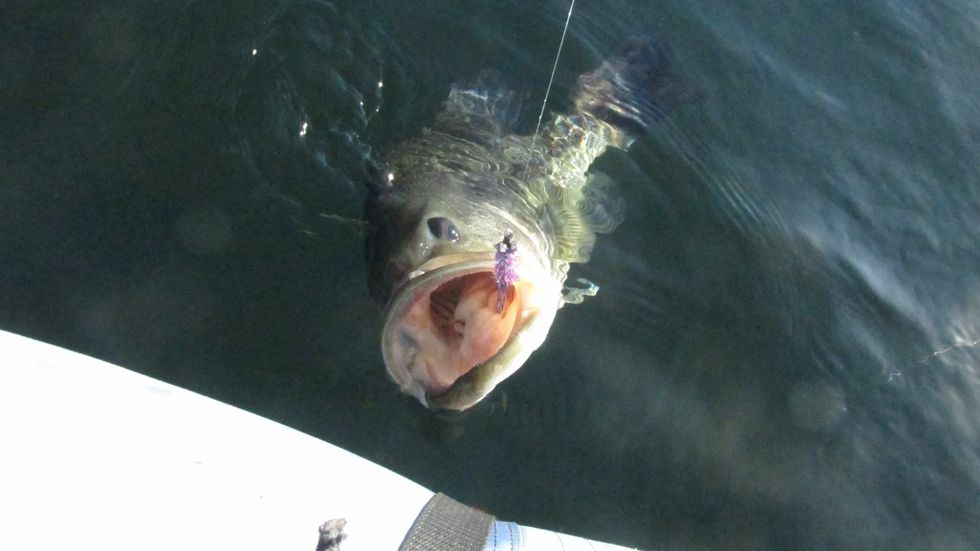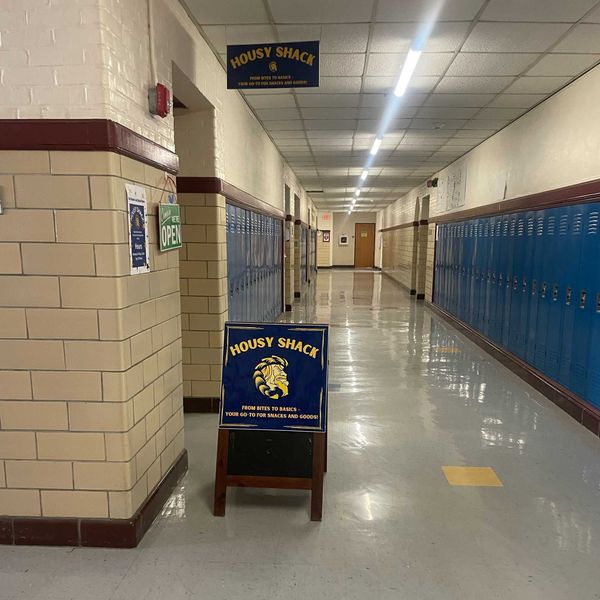Swerving into August angling

A largemouth bass, nicknamed Mongo, was the highlight of a previous warm-water fishing season. The fly in Mongo’s mouth is about an inch long, for reference.
Photo by Patrick L. Sullivan

Back in 2011, for Christmas my mother gave me a copy of “The Swerve: How the World Became Modern” by Stephen Greenblatt.
It’s a dense piece of learning, full of rich detail.
But because deep down I’m shallow, I didn’t get very far with it.
But the title made enough of an impression that I think of August as Swerve Month.
August is when I temporarily suspend trouting activities for the most part, focusing on fishing a warmwater lake for largemouth bass.
And whatever else might show up, such as smallmouth bass, pickerel, crappie, assorted panfish, perch, crab, lobster and very small alligators.
This type of fishing requires a swerve in thinking. There is nothing subtle about it. Success requires throwing large flies with heavy rods and making a fuss while doing so.
I’ll never forget learning the Yo-Yo Method when I was new to the warmwater game.
This involves attaching a heavy, weighted fly, like a Clouser, to a shortish, sturdy leader, in turn attached to a stout rod and line (line weight #8 is about right).
Tied to the bend of the hook of the weighted fly is two feet of thick tippet material, say 1X, and to that is tied a popper.
The popper is buoyant, but the weighted fly drags it down.
Once everything is submerged, the cunning angler simply jerks the whole shebang upwards.
The weighted fly comes up and then sinks again, causing the trailing popper to go up and down, like a yo-yo.
This also causes the angler to feel like a yo-yo.
However ungainly this maneuver, it does drive bass absolutely insane.
I generally bring two rods, one equipped with a floating line for surface action, and one with either an intermediate line (where the entire line sinks slowly) or a sink tip line (where a heavy section at the front of the line sinks quickly). You could also use removable sink tips, or a floating line with heavy flies, or added weight, or some combination of the above.
The rods are either weights 7 or 8.
I also use Tenkara rods, similarly equipped with floating or sinking lines, although with fixed-line fishing these distinctions don’t matter nearly as much. The fly either floats or it sinks, regardless of the line.
I fish from a pontoon boat, the small, portable, inflatable kind. It’s basically a floating chair, powered by a combination of oars and swim fins. I have also used an ancient leaky rowboat and a canoe. Somebody busted the oarlock on the former and the latter gets blown around too much.
The trick on this particular lake is to go out at dawn or at dusk. Unless it’s overcast, when the fishing tends to be consistent all day.
I target any sort of structure. Downed trees, vegetation that hangs over the water, sharp drop-offs.
Also, in this lake, there might be an old steam radiator or obscure piece of iron industry equipment moldering on the bottom.
I can always tell if I’ve hooked something like that. It doesn’t move.
It’s a restful sort of angling, for the most part. No sliding around on cobble. No getting the backcast caught in a bush.
One month of this is about right, too. By the end of August, I am usually bored by monstrous bass and looking forward to stalking skittish brookies or targeting large trout in moving water.
As for “The Swerve,” I’ve still got my copy. The classical head on the cover is looking at me in silent rebuke. So I will take another stab at it. I’ve got all month.
The Community Closet at HVRHS is open for students to take clothes for any reason during the school day.
What started with one unexpected donation of clothes has grown into a quietly impactful resource for all students at HVRHS: the Community Closet. Now located in a spacious area above the cafeteria, the closet offers free clothing to any student for any reason.
The idea began a few years ago when a community member reached out to the former superintendent wondering if anyone at the school could benefit from used clothing that would otherwise go to waste. The superintendent then got in contact with Rachel Novak, the school social worker. “Once I had all those bags of clothes in my room, I was like, ‘I should put this in a space,’” Novak said. Her simple idea eventually became a full-sized closet accessible to all students.
From the beginning, Novak envisioned the closet as an inclusive space. “It’s open to anybody, it’s not just based on economic needs,” she said. Sustainability also plays a role. “Thinking about the environment, some students like to thrift and just get clothes that way,” Novak said.
After the initial donation, contributions continued to grow. “I reached out to our staff members and faculty,” Novak said. The most consistent donations come from the faculty at HVRHS and a few community members who learned about the closet. Finding teenage-appropriate clothes has been a challenge. “I get a lot of donations that are nice, but I don’t think teenagers would want to wear them,” Novak said.
Another ongoing obstacle has been awareness. Many students don’t know the closet exists at all. “That’s been the hard part,” Novak said. “Getting it out to the wider community of the school.” Novak is looking for students and staff to spread the word. “It helps because our school nurse knows and other faculty members,” she said. “When they know a student needs something, they just bring them up.”
Looking ahead, she hopes to promote the space more actively. “When we come back from this break, I do plan to … get fliers and all that up and going,” Novak said. There may even be an upcoming expansion — she has discussed the possibility of turning part of the area into a food pantry. “That would be more of a need-based system for students,” she said. “But right now, promoting it is where I’m at.”
The Community Closet is well-stocked currently. “Just because of the amount of clothes I have, I’m not accepting any more donations until I clear some stuff out,” Novak said. She is still willing to make room for more fashionable, teen-friendly items donated by students. “That way I’ll have more teenager approved clothes.”
Above all, she wants students to know that no one is limited to using the space. “Sometimes there’s a stigma around it … like, ‘I don’t need help. I don’t want to take away from anybody else that may need it,’” Novak said. Due to the amount of clothes, students should feel welcome to use the closet for any reason. Some students even grab items last minute for sports and activities. “It’s important for kids to know it’s for everyone.”
Whether a student wants to thrift clothes sustainably, forgot to pack clothes for an after-school practice, or is in need of a new outfit, the Community Closet is a resource for all.
Sophomore Eliana Lang enjoys her Housy Shack cookie.
Now in its second year, the Housy Shack is a hit among students. The special education department-run store that sells warm cookies, drinks and other snacks to students and teachers draws people to a room in the back hallway every time it’s open.
The smell of warm cookies welcomes visitors to the store with snacks, drinks and even Housy merchandise for sale. The cookies are definitely the favorite, sometimes lines go out the door to get one before they sell out.
The cookies are so popular that the store had to increase prices from 50 cents to a dollar and implement a four cookie per person maximum. The Shack sells about 40-100 cookies per day and has about 20-60 HVRHS customers visiting per day.
Julie Browning and Heather Strid, two of the HVRHS faculty members that help run the Shack, said their goal was to create real-world job experiences as well as real-world shopping experiences for students at HVRHS. “Learning the skills to work in the world can be taught in a classroom, but the lessons are more meaningful and valuable when they are applied in real work situations, which is what we create through the school store,” Browning said.
The original purpose for the store seems to be working, as several students are learning important skills. Students said the store taught them skills like counting money, checking inventory and cleanliness along with social skills and customer service that could help in the professional world after high school.

As the store quickly became a hit, organizers were faced with the challenge of finding funding. “When we started planning to start the school store two years ago we needed money to buy equipment, supplies and food to start it up but were not sure how to get it,” Browning said. “Mrs. Strid came up with the idea of applying for a grant from the 21st Century Fund to help us get started and they were so generous.” That grant has been crucial to the success and growth of the school store.
Not only does the Housy Shack benefit the special education department, students said it fosters a sense of community throughout the school. “School store cookies are my favorite thing ever. They brighten up my day,” said Eliana Lang, a sophomore at HVRHS. Dayana, one of the student staffers at the Housy Shack, said her favorite part of working in the school store is when students come in to make purchases. She enjoys talking to them and ringing up their orders on the cash register. The Housy Shack brings people together and offers the opportunity for students to connect with each other.
As the school year continues, the members of the school store look forward to expanding their inventory by creating and selling a variety of Housy merchandise — t-shirts, sweatshirts, water bottles, and more. “I have had several students put in requests for certain hats, key chains, etc. … so there will be more of that to come,” Browning said. Last school year, profits were all invested back into the school store. “This year we are hoping to make more of a profit and will look to use the money that we make for field trips, outings as well as opportunities to donate and give back to the community,” Browning said. They also would like to use the school store to fundraise for other causes. “Right now we are collecting donations for The Little Guild Animal Shelter, so if anyone has pet supplies they would like to donate please drop them off in exchange for a cookie,” Browning said.